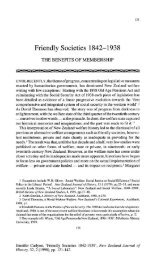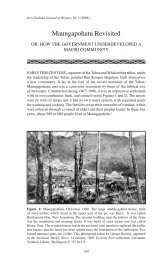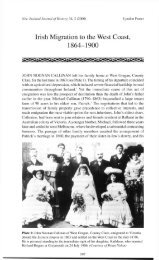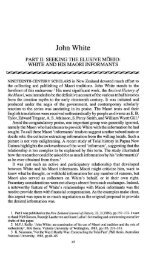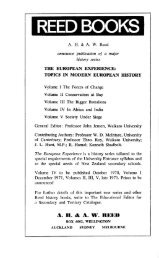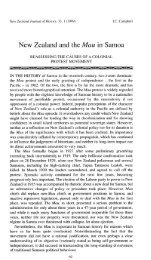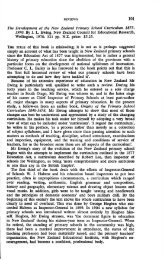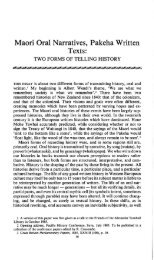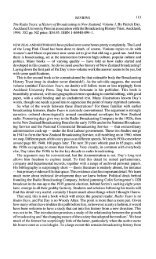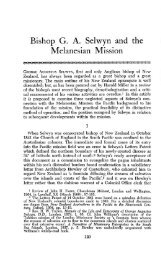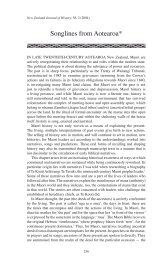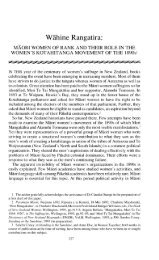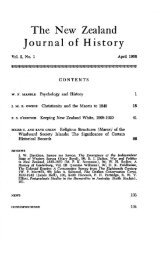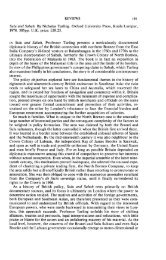Te Peeke o Aotearoa - New Zealand Journal of History
Te Peeke o Aotearoa - New Zealand Journal of History
Te Peeke o Aotearoa - New Zealand Journal of History
Create successful ePaper yourself
Turn your PDF publications into a flip-book with our unique Google optimized e-Paper software.
<strong>Te</strong> <strong>Peeke</strong> o <strong>Aotearoa</strong><br />
THE BANK OF KING TAWHIAO<br />
SOME OF the rarest <strong>New</strong> <strong>Zealand</strong> bank notes are those <strong>of</strong> <strong>Te</strong> <strong>Peeke</strong> o <strong>Aotearoa</strong>.<br />
Three public collections in <strong>New</strong> <strong>Zealand</strong> hold examples; a total <strong>of</strong> seven kotahi<br />
pauna (one pound) notes are known. 1 Two issued cheques on the bank, and two<br />
on the related Maungatautari <strong>Peeke</strong>, are also known. 2 Little has been recorded<br />
about the banks, or about their notes and cheques. Some <strong>of</strong> what has been written<br />
is clearly erroneous, and much <strong>of</strong> it is written from a very biased perspective.<br />
Several popular accounts suggest, none too subtly, that the banks were a<br />
misguided and ill-informed attempt by ignorant people to copy the methods <strong>of</strong><br />
the Pakeha banks. Numismatists have questioned whether the banks ever really<br />
existed, or whether they did in fact operate as banks. 3<br />
The best preserved <strong>of</strong> the one pound notes <strong>of</strong> <strong>Te</strong> <strong>Peeke</strong> o <strong>Aotearoa</strong> is in the<br />
Auckland Institute and Museum. 4 The note is printed in five colours on cream<br />
coloured paper. 5 The typography is florid, with use <strong>of</strong> Gothic script and elaborate<br />
curlicues in the design, mostly printed in black. The note bears the legends 'Ko<br />
<strong>Te</strong> <strong>Peeke</strong> o <strong>Aotearoa</strong>', 'Kotahi Pauna' and 'E whaimana ana tenei moni ki nga<br />
tangata katoa' ('This money is valid for all people'). Many <strong>of</strong> the design elements<br />
are themselves comprised <strong>of</strong> typography, using the words 'Kotahi' and 'Pauna'<br />
repeated many times. The centre <strong>of</strong> the note is dominated by a large letter 'N',<br />
whose legs are formed <strong>of</strong> the word 'Pauna' overprinted in pink; the diagonal is<br />
simply coloured green. A horizontal band is comprised <strong>of</strong> green triangles.<br />
Graphic elements are limited to two simple quatrefoils, which may be flowers,<br />
bearing the numeral '1', and a flowering flax bush at the lower left. The whole<br />
area within the border has a yellow ink wash, with other colours superimposed,<br />
and a series <strong>of</strong> horizontal yellow rules over the entire face <strong>of</strong> the note within the<br />
border, except where other design elements are present.<br />
At the top left and lower right is a space for the entry <strong>of</strong> a number on the note,<br />
with no number entered on the Auckland Museum example. At the lower right<br />
is printed in black the signature 'Tawhia.'. The '.' is certainly a full stop and not<br />
the 'o' one would expect at the end <strong>of</strong> the name 'Tawhiao'. The reverse <strong>of</strong> the<br />
1 See Table 1 for details.<br />
2 See Tables 2 and 3 for details.<br />
3 R.P. Hargreaves, From Beads to Banknotes, Dunedin, 1969,p.l 18; H.Mitchell, 'Maoris' bitter<br />
mood reflected in £1 note', Australian Coin Review (ACR), July 1984; A.F. Robb, 'The So Called<br />
"Bank <strong>of</strong> <strong>Aotearoa</strong>'", <strong>New</strong> <strong>Zealand</strong> Numismatic <strong>Journal</strong> (NZNJ), 17, 1 (1985), p.22 (top).<br />
4 See Figure 1.<br />
5 It measures 216 mm by 127 mm (8 5 inches by 5 inches).<br />
161
162 STUART PARK<br />
Figure 1<br />
note bears five circles printed in red, one in each corner and one in the centre. The<br />
central one has an infill <strong>of</strong> blue, in the centre <strong>of</strong> which, in negative, is the numeral<br />
"1'. These circles show through clearly to the face <strong>of</strong> the note.<br />
The whole note is elaborately presented, with much use <strong>of</strong> decorative curlicues<br />
in black. Five colours have been used to print the note: black for most text, yellow<br />
for the background and the horizontal rules, red, green and blue. Different shades<br />
<strong>of</strong> green and red/pink are present, but this appears to be a result <strong>of</strong> the<br />
overprinting <strong>of</strong> two or more inks, such as yellow and red or green and yellow,<br />
rather than the use <strong>of</strong> separate shades <strong>of</strong> colour. At the upper right <strong>of</strong> the note,<br />
viewed from the reverse, is a large watermark, the name 'HODGKINSON'. The<br />
note has been folded in half, once vertically and once horizontally. Apart from<br />
this, it is in excellent condition, and has clearly never been used, its condition<br />
confirming the evidence <strong>of</strong> the lack <strong>of</strong> numbering.<br />
A second note in Auckland Museum is much more worn; it is dirty and rather<br />
frayed at the edges. It is slightly smaller (205mm by 120mm). The size difference<br />
cannot be attributed to degradation <strong>of</strong> the edges <strong>of</strong> the note, since the printed area<br />
and the type faces are all uniformly smaller. It is possible that the whole note has<br />
shrunk, due to water. The horizontal rules are printed in black on this note, not<br />
in yellow. Apart from the size difference, and the dirt, wear and fading, the notes<br />
otherwise appear to have been very similar.<br />
The note in the Alexander Turnbull Library is similar, although in poorer<br />
condition than the better Auckland note. However, the watermark is in a different<br />
position.<br />
The Reserve Bank note is a little different again. The name 'Tawhia.' is not<br />
present at bottom right. There is no watermark. The green colour is darker, and<br />
several elements are coloured differently.
TE PEEKE O AOTEAROA 163<br />
The Wellington numismatist's note is similar to the Reserve Bank note, but<br />
differs from it in a number <strong>of</strong> ways. The name 'Tawhia.' is absent.The green <strong>of</strong><br />
the triangles and the 'N' is the darker green, though the green is slightly less bold<br />
than the Reserve Bank note, and there are some other colour variations. No rules<br />
are visible at all, nor is any colour wash apparent in the field enclosed by the<br />
border. Pink flowers are added to the green buds <strong>of</strong> the flax bush. The note is<br />
numbered '000' at top left and centre right, with a printed serial number. The<br />
circles in the four corners <strong>of</strong> the reverse <strong>of</strong> the note have coloured infills, purple<br />
and yellow, with the numeral ' 1' in negative in each. The centre circle infill is<br />
the same blue as all the other notes. One further point <strong>of</strong> interest is the presence<br />
on the reverse <strong>of</strong> the note <strong>of</strong> two rubber stamp impressions, which also appear<br />
on some <strong>of</strong> the cheques. The circular stamp bears around the rim the words 'INGI<br />
KITAWHIAO O KEN ANA', and in the centre what is either a feather plume,<br />
or perhaps a shooting star (comet).<br />
The Sydney 'Rapata' note (currently known only as a monochrome image) 6<br />
is burned and damaged at the lower right, so it is not possible to tell whether<br />
'Tawhia.' is present. This note is numbered '0000' at top left and centre right.<br />
Ray Hargreaves has commented that the numbering on this and the Wellington<br />
numismatist's note is the normal method <strong>of</strong> numbering specimen bank notes. 7<br />
The Turangawaewae note has not been sighted by the author.<br />
Apart from the presence or absence <strong>of</strong> 'Tawhia.' and the rules, and the colour<br />
variations, all the notes appear to be identical. Thus it seems that all the notes<br />
were printed from the same printing block, from which the name 'Tawhia.' and<br />
the rules were absent for some notes, several <strong>of</strong> which have slightly different<br />
colour combinations.<br />
It is not possible to say whether the different notes represent variants produced<br />
at one printing, or were printed at different times, representing alterations or<br />
corrections. The sparse historical evidence is silent on this point. In particular,<br />
it is not known whether the Wellington numismatist's and the Reserve Bank<br />
notes are earlier, and 'Tawhia.' was added later in printing the other notes, or<br />
whether this is the later version, correcting the misspelling <strong>of</strong> Tawhiao by<br />
omitting it. The colour variations noted may also be related to several printings,<br />
or to different trials in a 'pro<strong>of</strong> stage <strong>of</strong> printing.<br />
There are two extant issued cheques on <strong>Te</strong> <strong>Peeke</strong> o <strong>Aotearoa</strong>. In addition, two<br />
unused cheque forms exist, and there is a published account <strong>of</strong> a third. 8 The<br />
following description is based on the issued cheque <strong>of</strong> <strong>Te</strong> <strong>Peeke</strong> o <strong>Aotearoa</strong> in<br />
Auckland Museum. 9 The left margin is perforated, where the cheque has been<br />
detached from the butt. 10 The upper medallion to the right <strong>of</strong> the perforation show<br />
a standing Maori warrior, with a (?korowai) cloak, and bearing a patu in his right<br />
6 Illustrated in Vernon Roberts, Kohikohinga: Reminiscences and Reflections <strong>of</strong> 'Rapata'<br />
(Vernon Roberts), Auckland, 1929; Mitchell, p. 53; Robb, p. 22.<br />
7 Letter to author, 1990.<br />
8 See Table 2.<br />
9 See Figure 2.<br />
10 Auckland Museum also has an unissued cheque form, with the butt section intact. That cheque<br />
is numbered 150.
164 STUART PARK<br />
hand. The lower medallion has three trees and three huia pecking at the ground,<br />
with the words 'Totara' and 'Huia'. Between the two medallions are the words<br />
'Ko <strong>Te</strong> utu Kei <strong>Te</strong> <strong>Peeke</strong>'. 11 Below is a canoe with four-seated paddlers, and a<br />
standing figure in the prow pointing up to two crescent moons and a six-pointed<br />
star, joined to each <strong>of</strong> the crescents by a ribbon. To the right <strong>of</strong> the medallions<br />
is a line <strong>of</strong> text, printed vertically, 'He Mea Ta ki te Whare o te Pere Pukapuka<br />
i Akarana'. 12<br />
At the top left is 'No. 417'. Below that is 'Ko <strong>Te</strong> <strong>Peeke</strong> o <strong>Aotearoa</strong>', using the<br />
same typeface as the kotahi pauna bank notes. On the right is a dotted line for the<br />
date, with '188' printed and more dots for the actual year to be entered. The date<br />
'Hune 27', (June 27) has been written, and the second '8' overwritten with a '9',<br />
followed by a '4'. Thus the cheque is dated 27 June 1894.<br />
The next line begins 'Kia' ('To') in printed script, followed by dots. The same<br />
form is used for the next lines, which begin 'Hoatu Kia' ('Give to') and<br />
'Ngamoni' ('The amount'). To the right is 'Na' ('From') and a dotted line. The<br />
cheque is signed ('Na') by T.T. Rawhiti, and instructs ('Kia') Tupu Taingakawa<br />
to pay to ('Hoatu Kia') Paupoaka the sum <strong>of</strong> ('Ngamoni') 'Kotahi Pauna' ('One<br />
Pound').' 1 "0"0' has been entered after the '£' at bottom left. This is thus a bank<br />
cheque form, not a personal cheque. It instructs a person (Tupu Taingakawa) to<br />
give money (one pound) to a third party (Paupoaka) from the issuer (T.T.<br />
Rawhiti), presumably the bank manager or owner. The significance <strong>of</strong> these<br />
individuals' names will be discussed below. Diagonally across the face <strong>of</strong> the<br />
cheque, the words 'Kua utua' ('Paid') have been written in red ink.<br />
The second issued cheque is in <strong>Te</strong> Awamutu Museum. The cheque is number<br />
366. It is dated 'Mai 21 1894', and instructs <strong>Te</strong> Ngaroroa to give 'e rua Pauna'<br />
('two pounds'). The printed words 'Hoatu Kia' have been struck through with<br />
a stroke <strong>of</strong> the pen, and the words 'Mo te Pirihimana' ('For the Policeman')<br />
written. The cheque is signed by T.T. Rawhiti. The handwriting and signatures<br />
on the two cheques appear to be the same. The cheque has been endorsed in red<br />
ink, with 'Kua utua', as in the Auckland Museum example, and below that, now<br />
considerably faded, '<strong>Te</strong>nei Moni' ('This Money has been paid'). 13 The endorsements<br />
on the two cheques also appear to have been written by the same hand.<br />
Two cheques are known from another bank, Maungatautari <strong>Peeke</strong>. 14 The<br />
cheques are identical with those <strong>of</strong> <strong>Te</strong> <strong>Peeke</strong> o <strong>Aotearoa</strong>, except for the words<br />
'Maungatautari <strong>Peeke</strong>' in place <strong>of</strong> 'Ko <strong>Te</strong> <strong>Peeke</strong> o <strong>Aotearoa</strong>'. The same type face<br />
is used for the substitute name, and the same printer's legend runs vertically<br />
along the left edge <strong>of</strong> the body <strong>of</strong> the cheque.<br />
The Maungatautari cheque in <strong>Te</strong> Awamutu Museum is unissued, with the<br />
serial number 48. On the right hand side, immediately below the printed '188'<br />
<strong>of</strong> the date, is a circular rubber stamp impression 'INGI KI TAWHIAO O<br />
11 'This is money at the bank.'<br />
12 'A thing done at the House <strong>of</strong> the Bell Books in Auckland' — perhaps better rendered as<br />
'Printed at the Bell Press Auckland'.<br />
13 I am grateful to staff <strong>of</strong> the Auckland City Art Gallery for technical assistance in enhancing<br />
these faded words to allow them to be deciphered.<br />
14 See Table 3.
TE PEEKE O AOTEAROA 165<br />
Figure 2<br />
KENANA', as on the Wellington numismatist's specimen <strong>of</strong> the <strong>Peeke</strong> o<br />
<strong>Aotearoa</strong> Kotahi Pauna note.<br />
A second cheque <strong>of</strong> Maungatautari <strong>Peeke</strong> is in the museum <strong>of</strong> the Cambridge<br />
Historical Society. It is cheque number 47, and has been issued. It also bears the<br />
same rubber stamp impression, in the same place. It is dated 'Maehe 17th 1905'<br />
('March 17th 1905'). It instructs Wi Pewhairangi to pay to Henare Matanuku the.<br />
sum <strong>of</strong> 'E rima rau pauna' ('five hundred pounds'). The cheque is signed 'Ingi<br />
Ki Tawhiao'. The handwriting is different from the two <strong>Te</strong> <strong>Peeke</strong> o <strong>Aotearoa</strong><br />
cheques signed by T.T. Rawhiti. Written in pencil on the reverse <strong>of</strong> the cheque<br />
is the name Charles Cuttle. 15<br />
The cheque was presented to the Cambridge Museum by Cuttle's daughter,<br />
Mrs T. Hounslow <strong>of</strong> Leamington, Cambridge. Mrs Hounslow described the time<br />
when, aged sixteen, she rode across the Maungakawa Hills and explored:<br />
the old Maori meeting house, the former residence and parliament building <strong>of</strong> King<br />
Tawhiao ....<br />
Early in the century the pa was abandoned, probably because <strong>of</strong> a serious epidemic. The<br />
meetinghouse was left with its valuable contents, but was regularly visited by the Maoris<br />
to check on its condition.<br />
However, at the time <strong>of</strong> Mrs Hounslow's visit it was in a dilapidated state .... Inside<br />
... the floor was littered with papers. Among these, Mrs Hounslow found two cheques,<br />
one for £ 1 and the other for £500 drawn on the old Maungatautari Maori B ank and signed<br />
by King Tawhiao. The one for £500 has been presented to the Historical Society by Mrs<br />
Hounslow. 16<br />
15 Cuttle was a sergeant <strong>of</strong> Armed Constabulary stationed in Cambridge. E. Parker, Cambridge<br />
Historical Society, interview with author, 1990.<br />
16 The gift is described in an article in the Cambridge Independent, a cutting <strong>of</strong> which is in the<br />
Cambridge Museum. The date is 14 September, but the year is uncertain.
166 STUART PARK<br />
Another cheque <strong>of</strong> Maungatautari <strong>Peeke</strong> was described, though not illustrated,<br />
in 1916. 17 It is cheque number 401, dated 3 June 1886, and is described as<br />
reading:<br />
Kia Kua rire atu i a Kerei Kai<br />
Whakawa tuturua Tawhiao<br />
Ngamoni o <strong>Te</strong> <strong>Peeke</strong> o Maungatautari<br />
£4 0 0 No Tukere<br />
This seems to be a misunderstood mixture <strong>of</strong> the printed and written text on the<br />
cheque. As noted below, in a reprint <strong>of</strong> the article in an unknown journal, a<br />
photograph <strong>of</strong> that cheque appears, with the caption 'Cheque on the first and only<br />
Maori Bank, from the original in the possession <strong>of</strong> Mr Alfred Giblin, Opapa,<br />
Hawke's Bay'. The cutting is indistinct, but it seems that the printed 'Kia' has<br />
in fact been struck out, and the words 'Kua rire atu i a Kerei Kai' written on the<br />
first line. The printed 'Hoatu kia' is obliterated by the writing on the second line.<br />
The 'No' is in fact the printed 'Na'. The meaning is not completely clear, but it<br />
might be read that the cheque is signed by Tukere, asking that the sum <strong>of</strong> £4 be<br />
given to Kerei Kai.<br />
Four contemporary accounts <strong>of</strong> these banks exist. The first appeared in the<br />
Waikato Times 12 December 1885. Its supercilious, patronising attitude set the<br />
tone for much <strong>of</strong> the later writing.<br />
And so the prospectus was sent out, the hat was passed round, a whare with a strongroom<br />
in the ground was licked into shape as an <strong>of</strong>fice, a committee <strong>of</strong> self-appointed gentlemen<br />
took the management in hand and now the whole establishment is in full swing and<br />
prospering.<br />
We have before us a copy <strong>of</strong> the rules respecting loans By the Rule 4 the Committee<br />
may consent to any money being advanced for important tribal purposes, such as, perhaps<br />
sending Tawhaio [sic] or Major <strong>Te</strong> Wheoro on courtesy trips abroad It is to be hoped<br />
that [the funds] will not be invested in interminable lawsuits upsetting titles already fixed<br />
by the Land Court, or starting a jockey club, speculations in general favour amongst<br />
natives.<br />
In respect to its <strong>of</strong>ficials and clerks, the Maungatautari bank is well up to date. The<br />
clerks, following the example <strong>of</strong> their brothers <strong>of</strong> the European establishment, have<br />
already resorted to paper collars, penny cigarettes and moustache dye and will no doubt<br />
endeavour to cultivate the civility to customers for which bankers are so remarkable. 18<br />
It should be noted that Maungatautari was a major centre <strong>of</strong> Maori settlement,<br />
and had long been sought by Europeans eager to farm its land. The land was<br />
purchased in 1873 but settlement was delayed until 1881, due to Maori opposi-<br />
17 Australasian Insurance and Banking Record (AIBR), 21 June 1916, p.481.<br />
18 Quoted in Eric Beer and Alwyn Gascoigne, Plough <strong>of</strong> the Pakeha: a Cambridge Regional<br />
history, Cambridge, 1975, p.286. Beer and Gascoigne consistently misspell the King's name as<br />
'Tawhaio'.
TE PEEKE O AOTEAROA 167<br />
tion, and even then trouble had continued. Maori initiative at Maungatautari was<br />
unlikely to be well received by the Pakeha press.<br />
The second article is much fuller <strong>of</strong> detail, but seems to have derived from the<br />
same source. This was possibly not its first appearance, since it begins:<br />
A Maori Bank<br />
A <strong>New</strong> <strong>Zealand</strong> correspondent has favoured us with an extract from a Napier paper<br />
published in 1886, containing an account by Mr J.F. Edgar, <strong>of</strong> the Maungatautari Bank<br />
which existed at Maungatautari some years previously. 19<br />
It was noted that following sittings <strong>of</strong> the Native Land Court, large sums <strong>of</strong><br />
purchase money were paid to the tribal owners, who deposited this firstly in<br />
Pakeha banks, but then reasoned that if Europeans could make money from<br />
banks, the Maori could too.<br />
A board <strong>of</strong> directors was appointed, mostly well-known chiefs, selected from various<br />
tribes. Two half-castes who had an English education were engaged as clerks or bookkeepers.<br />
The prospectus was in Maori, a translation being as follows:<br />
The Maungatautari Money House<br />
Board <strong>of</strong> Directors<br />
rt<br />
<strong>Te</strong> Kaikoura (the Fisheater)<br />
<strong>Te</strong> Reiputa (the Boar with Tusks)<br />
Hame te Pungorungoru (Sam the Sponge)<br />
<strong>Te</strong> Whakatoi (the <strong>Te</strong>aser)<br />
Wiremu te Tapu (William the Holy)<br />
Hone te Parikou (John Slippery Fish)<br />
<strong>Te</strong> Kaipuratoke (The Glowworm Eater)<br />
Aperahama te Rei (Abraham the Jewel)<br />
To the Maori People: Greetings<br />
Whereas it has come to the knowledge <strong>of</strong> the foregoing chiefs that the people <strong>of</strong> the tribes<br />
Ngatihaua, Ngatikapiti, Ngatimaniapoto, Ngatiraukawa, Ngatitirangiwehewehe and<br />
Ngatiwaikato have been in the habit <strong>of</strong> banking with certain Europeans;<br />
And whereas the Maori people so banking have been grievously wronged in their dealings<br />
with these Europeans, who have largely pr<strong>of</strong>ited thereby;<br />
And whereas our hearts being greatly grieved at this robbery <strong>of</strong> our people:<br />
Be it known, therefore, that we the chiefs <strong>of</strong> the tribes aforementioned, in Council<br />
assembled, have decided to start a bank for the use <strong>of</strong> the Maori people.<br />
The rules upon which this bank will be conducted are:<br />
1 The right to share in the privileges <strong>of</strong> the Maungatautari bank is confined to people <strong>of</strong><br />
the Maori race.<br />
19 AIBR, 21 June 1916, p.481.
168 STUART PARK<br />
2 No deposit will be accepted for a shorter period than six months<br />
3 The rates <strong>of</strong> interest to be paid on deposits are: On all sums under £20,5 per cent; over<br />
£20 and under £50, 10 per cent; over £50 and less than £100, 15 per cent; over £100, 20<br />
percent.<br />
4 The bank will be open to receive deposits on Mondays, Wednesdays and Saturdays<br />
between the hours <strong>of</strong> 10 a.m. and 4 p.m.<br />
(Signed) TAMAITI NIKOREMU<br />
The article continued to describe the premises <strong>of</strong> the bank, and quoted further<br />
from Edgar's article concerning the progress <strong>of</strong> the bank:<br />
Some weeks after the bank commenced business it became apparent that two or three <strong>of</strong><br />
the directors had unlimited resources at their disposal.... 'William the Holy' was the<br />
owner <strong>of</strong> a buggy and pair; the 'Boar with Tusks' had commenced the erection <strong>of</strong> a villa<br />
residence a la Anglaise; the 'Glow Worm Eater' evinced a relish for succulent mutton and<br />
bottled stout; and the 'Slippery Fish' figured in sporting circles as the owner <strong>of</strong> a racing<br />
stud those connected with the bank were the envy <strong>of</strong> all Maoridom. Opposition banks<br />
were talked <strong>of</strong>, and attempted, but without success. The clients appeared to be all used up.<br />
It was then reported that the directors decided that the best ose <strong>of</strong> the bank's<br />
money would be to finance a Maori mission over 'the Treaty <strong>of</strong> Waitangi — that<br />
old subject so dear to the heart <strong>of</strong> every Maori orator'. The mission would go to<br />
England, to 'the great pakeha Queen, the redresser <strong>of</strong> all wrongs. The Maoris had<br />
been robbed <strong>of</strong> their inheritance, their children were landless, and their chiefs<br />
without mana. Let them go to England and lay their petition before the Queen.<br />
The money <strong>of</strong> the bank could not be spent in a better cause. Was not the mission<br />
in the interests <strong>of</strong> the people? What, therefore, more reasonable than that the<br />
Maori people should pay for it?' It was decided that the chiefs who went to<br />
England should be <strong>Te</strong> Rei and <strong>Te</strong> Parikou, since they were 'chiefs <strong>of</strong> Ngatiwaikato;<br />
and had not the ancestors <strong>of</strong> Ngatiwaikato killed, cooked and eaten the ancestors<br />
<strong>of</strong> Ngatipatu and Ngatikoru?'<br />
The article continued by noting that at the end <strong>of</strong> the six months, depositors<br />
came to claim their money from 'Homai-te-utu, the clerk in charge'. When he<br />
told them that the directors had taken all the money to England, they tore down<br />
the bank building and burned it. When the directors subsequently returned, they<br />
told the people that the Queen had agreed to 'give back all their lands, and restore<br />
the chiefs to their ancient mana. As for the money in the bank which they had<br />
taken what <strong>of</strong> that? Did they not know it was the custom <strong>of</strong> all banks to charge<br />
interest? . . . The interest they had charged had eaten up all the principal.' In<br />
conclusion, cheque number 401 <strong>of</strong> 3 June 1886, referred to above, was described.<br />
The tone <strong>of</strong> this article is very negative, typical <strong>of</strong> much Pakeha writing about<br />
Maori <strong>of</strong> the later nineteenth and early twentieth centuries. Much <strong>of</strong> the content<br />
might well be factual, like the description <strong>of</strong> grievances over Treaty issues,<br />
although the names given to the chiefs appear so strange as to be quite unlikely.<br />
No contemporary Maori sources examined record such names. Ann Parsonson<br />
has noted that contemporary Pakeha newspaper accounts <strong>of</strong> Maori and espe-
TE PEEKE O AOTEAROA 169<br />
cially Kingite activities may be quite unreliable: 'The Auckland papers <strong>of</strong> the<br />
period were notoriously unreliable in their reporting <strong>of</strong> Maori news, even going<br />
so far as to give accounts <strong>of</strong> meetings which had not occurred. The Waikato<br />
Times, though not above reproach in this respect, has proved far more useful.' 20<br />
In spite <strong>of</strong> its dubious reliability, this article has had a long life, probably because<br />
<strong>of</strong> its 'coon humour' style. It has been reprinted, quoted or extracted several times<br />
over a century-long period from its supposed 1886 origin.<br />
It was reprinted in another <strong>New</strong> <strong>Zealand</strong> journal, possibly the Auckland<br />
Weekly <strong>New</strong>s, at an unknown date. 21 The article appeared again in <strong>Te</strong> Ao Hou, 22<br />
where J.F. Edgar was identified as a former Maori Land Court Judge. The same<br />
story was reprinted in the Special Centennial Supplement <strong>of</strong> the Waikato<br />
Independent in 1964, and in the centenary issue <strong>of</strong> the Waikato TimesP It<br />
appeared again in the <strong>Te</strong> Awamutu Historical Society <strong>Journal</strong> 24 None <strong>of</strong> these<br />
reprints has any reference to a cheque, nor to an illustration. A curious reprint <strong>of</strong><br />
the same article acknowledged Mr Jim Day <strong>of</strong> Hamilton for 'permission to<br />
reprint this amazing true tale which he wrote about 1931 Mr Arthur Moore,<br />
<strong>of</strong> Cambridge, another historical enthusiast, adds a footnote about a second bank<br />
that was set up not far away at Maungakawa, about the same time'. 25 How Day<br />
could have written this story in 1931, when it had first been published in 1886,<br />
is not explained. The note continues:<br />
Members <strong>of</strong> the Society who took part in the trip to the Cambridge district will remember<br />
what they learned from Mr Moore and Mr Day, who handed out 'cheques' on the<br />
Maungatautari bank.<br />
Grotesque and laughable as it is, the story has rather sad undertones. No doubt there<br />
were faults and deficiencies on both sides so long ago, but the present-day pakeha can only<br />
regret that his forebears took many years to learn the now obvious duty <strong>of</strong> safeguarding<br />
Maori interest in respect to money and property.<br />
A Maori perspective on the Pakeha safeguarding <strong>of</strong> Maori money and property<br />
might be rather different.<br />
20 Anne R. Parsonson, '<strong>Te</strong> Mana o te Kingitanga Maori: a study <strong>of</strong> Waikato-Ngatimaniapoto<br />
relations during the struggle for the King Country 1878-1884', MA thesis, University <strong>of</strong> Canterbury,<br />
1972, p.v.<br />
21 Cutting in <strong>Te</strong> Awamutu Museum files, said to be a photocopy <strong>of</strong> an original in the Turnbull<br />
Library. Here, the reference to the cheque at the end is deleted, but a new sub-heading reads 'see<br />
Illustration Page 25'. Unfortunately, the <strong>Te</strong> Awamutu Museum cutting does not include the<br />
illustration. However, the undated cutting in the Turnbull Library (MS 3652), which bears the note<br />
'(See "A Maori Bank" page 4)' is an illustration <strong>of</strong> the same cheque described in the 1916 article,<br />
no. 401 <strong>of</strong> Maungatautari <strong>Peeke</strong>, dated 3 June 1886. The reverse <strong>of</strong> this cutting carries the<br />
photographs <strong>of</strong> three <strong>New</strong> <strong>Zealand</strong> soldiers who were killed on 26 September, 26 October and 14<br />
December 1916. The cutting is on glossy paper like that <strong>of</strong> the Auckland Weekly <strong>New</strong>s, but the size<br />
<strong>of</strong> the photographs does not match the size used in that journal for private soldiers, as these men were.<br />
Efforts to trace the origin <strong>of</strong> the cutting have so far failed.<br />
22 N.M. Chappie, 'The Maori Bank at Cambridge', <strong>Te</strong> Ao Hou, 29 (1959).<br />
23 24 August 1964, p. 99.<br />
24 'The Maungatautari Bank', II, 4 (1987), pp.101-4.<br />
25 J. Day, 'The Great Maori Bank, Its Rise and Fall', <strong>Journal</strong> <strong>of</strong> the Auckland Historical Society<br />
9 (1950) pp. 18-20.
170 STUART PARK<br />
The cheques handed out on the Auckland Historical Society field trip were<br />
reproductions <strong>of</strong> the Maungatautari <strong>Peeke</strong> cheque no.47 in the Cambridge<br />
Museum. These were printed, probably at the <strong>of</strong>fices <strong>of</strong> the Cambridge Independent,<br />
on buff and on green paper, at a reduced size. 26 Several <strong>of</strong> these<br />
reproduction cheques are still in the Cambridge Museum, while others are<br />
privately held around the district.<br />
The article purportedly written by Day contains some embellishments not<br />
found in the 1916 original, but it is clearly derived from the same source,<br />
although it also contains several misspellings <strong>of</strong> the Maori names. Headed<br />
'Banking and the Turf, the concluding note, attributed to Moore, records the<br />
existence <strong>of</strong> a second Maori bank, at Maungakawa,<br />
born <strong>of</strong> distrust <strong>of</strong> the pakeha and conducted in abysmal ignorance <strong>of</strong> the principles <strong>of</strong><br />
usury.<br />
Names <strong>of</strong> literate Maoris associated with the Bank <strong>of</strong> Maungakawa were Rawhiti and<br />
<strong>Te</strong>nei te Whakaraina. Maungakawa had a different approach to the problem <strong>of</strong> securing<br />
interest. Instead <strong>of</strong> an approach to Wikitoria and her ministers, the bold and brave Rawhiti<br />
had another plan; he attended local race meetings and invested the bank deposits on the<br />
contemporary Carbines, Phar Laps and Cardigan Bays. Like snow upon the desert's dusty<br />
face, the deposits melted away.<br />
A pale remnant <strong>of</strong> the Maungatautari Maori settlement still exists, but Maungakawa,<br />
once 4,000 strong, was vacated in the late 90's, after a particularly vicious epidemic with<br />
substantial child mortality.<br />
The same story <strong>of</strong> the Maungatautari bank has been used as a source by Lowrie 27<br />
and by Parker 28 in their local histories <strong>of</strong> Cambridge. Parker notes that this was<br />
'a somewhat naive attempt to rival the two established Cambridge banks'. 29 It<br />
seems highly probable that Moore's 'Bank <strong>of</strong> Maungakawa' is in fact <strong>Te</strong> <strong>Peeke</strong><br />
o <strong>Aotearoa</strong> or Maungatautari <strong>Peeke</strong>, which clearly operated at Maungakawa.<br />
The second contemporary account is that <strong>of</strong> Rapata, or Vernon Roberts. 30<br />
Roberts was a trader in the King country, who had a good rapport with many <strong>of</strong><br />
the Maori people there, including King Tawhiao. Roberts uses pseudonyms for<br />
some <strong>of</strong> those about whom he writes, though he also refers to people by their true<br />
names — Tawhiao is referred to throughout by his proper name. In a section<br />
headed 'Progressive Plans for Primitive People' , 31 Roberts writes about 'Tawhiri,<br />
a chief <strong>of</strong> chiefs, a rangatira in every sense <strong>of</strong> the word .... His knowledge <strong>of</strong><br />
the ways <strong>of</strong> the pakeha as an individual was extensive, but he was less well<br />
informed concerning the white man's system <strong>of</strong> government, the public service<br />
and matters <strong>of</strong> finance ... some very elementary ideas regarding these matters<br />
had been conveyed to the old gentleman by his chiefs <strong>of</strong> staff In due course,<br />
26 The total dimension <strong>of</strong> the paper is 226 mm x 98 mm, with the image <strong>of</strong> the cheque smaller.<br />
27 Meryl Lowrie, A Century <strong>of</strong> Service: BNZ in Cambridge, Cambridge, 1975.<br />
28 Sally K. Parker, Cambridge, an illustrated history 1886-1986: the centenary <strong>of</strong> local government<br />
in Cambridge, Cambridge, 1986.<br />
29 ibid., p.47.<br />
30 Kohikohinga, 1929.<br />
31 ibid., pp. 155-6.
TE PEEKE O AOTEAROA 171<br />
Tawhiri, His Secretary <strong>of</strong> State for War and Ministers for Finance and Internal<br />
Affairs set sail for Windsor Castle'. On his return, 'Tawhiri' called on Roberts,<br />
and told him that the Maori were to have their own Post Office, and Rapata would<br />
be Postmaster General.<br />
'The Maoris are going to have their own Banks too' was the next remark. 'See, I have the<br />
bank notes now' and forthwith the old fellow produced a bulky book <strong>of</strong> nicely printed<br />
bank notes, numbered from one upwards, each <strong>of</strong> the 'face value' <strong>of</strong> £1. Gravely, he tore<br />
out the first one and presented it to me. I have it now [he gives a general description <strong>of</strong><br />
the <strong>Te</strong> <strong>Peeke</strong> o <strong>Aotearoa</strong> bank note]....<br />
As there was certainly not then any Bank <strong>of</strong> <strong>Aotearoa</strong> and not likely to be, I was rather<br />
tickled with the idea <strong>of</strong> the notes. Nevertheless, I had no wish to see the old gentleman<br />
involved in difficulties, so I did my best to explain that if any <strong>of</strong> the notes were issued he<br />
might be called upon to redeem them. I must have made an impression because I heard<br />
no more <strong>of</strong> the notes, or <strong>of</strong> the bank or the Post Office — and I certainly didn't get the<br />
Postmaster Generalship.<br />
Roberts published a photograph <strong>of</strong> the bank note 'Tawhiri' had given to Rapata<br />
as a frontispiece to Kohikohinga. The note itself passed with Roberts' papers to<br />
the Auckland Coin and Bullion Exchange, through whom it was sold at auction<br />
in Sydney. Its current whereabouts are unknown.<br />
Rapata's account presents several puzzles. Who was 'Tawhiri'? Robb 32 and<br />
Mitchell 33 both assume that he is Tawhiao ('Tawhaio' in Mitchell). Certainly, his<br />
rangatira status is appropriate to Tawhiao, and his visit to the Queen in England<br />
with his secretary <strong>of</strong> state for war and ministers seems almost correct. There were<br />
four Maori members <strong>of</strong> the 1884 delegation to London as well as Tawhiao: Major<br />
<strong>Te</strong> Wheoro MHR (Secretary <strong>of</strong> State for War?), Patara <strong>Te</strong> Tuhi, who acted as<br />
secretary (Minister <strong>of</strong> Internal Affairs?) Topia Turoa and Hori Ropia, as well as<br />
George Skidmore, the interpreter. Tawhiao was about 59 when he went to<br />
London, so perhaps 'old gentleman' is appropriate. The name however is a<br />
puzzle, since Rapata frequently refers to Tawhiao by name in other parts <strong>of</strong> the<br />
book. Further, since T.T. Rawhiti was clearly associated with the banks, it must<br />
be noted that 'Tawhiri' is an anagram <strong>of</strong> 'Rawhiti'.<br />
The third contemporary account is perhaps the most helpful. It is regrettable<br />
that it was published in an obscure newspaper and has escaped subsequent<br />
notice; for those reasons it is quoted extensively here, from the original in the<br />
Waipa Post. 34 The headline reads:<br />
A MAORI BANK<br />
FOR KING TAWHIAO'S TREASURY<br />
IDEA ORIGINATED AT PARAWERA<br />
The article reports that discussion in parliament over Ratana's bank had<br />
32 Robb, pp. 18-22.<br />
33 Mitchell, pp.52-3; Numismatic Listing September, Auckland Coin and Bullion, 1984, p.7.<br />
34 11 November 1924.
172 STUART PARK<br />
stimulated a letter from Andrew Kay <strong>of</strong> Parawera 'than whom there is probably<br />
no white man better informed on Maori affairs <strong>of</strong> the past fifty or sixty years in<br />
this part <strong>of</strong> the Dominion'. Kay recalled that:<br />
when King Tawhiao and his followers took up their residence at Parawera many years ago<br />
they were considerably exercised about revenue. After due deliberation on the problem<br />
they appointed a Maori magistrate, also a clerk <strong>of</strong> the Court and a policeman, to adjudicate<br />
on all cases <strong>of</strong> dispute between the natives, and collect fees there from, such moneys to<br />
be devoted to endowing the Maori King's treasury. They also issued auctioneer's and<br />
business licenses, and encouraged pakehas to trade in their territory. By the way, I got the<br />
license forms printed for them in Auckland. They also aspired to do a banking business.<br />
With a shilling box <strong>of</strong> schoolboy's sketching colours they reproduced some very fine<br />
specimens <strong>of</strong> one, five and ten pound notes. I got sample specimens <strong>of</strong> those notes printed<br />
for them in Auckland. In the meantime the King and his counsellors were acquiring<br />
considerable sums <strong>of</strong> money to start the banking and lending business. I did not at the time<br />
bother to enquire where the capital was coming from, but believe there were many<br />
straight-out grants <strong>of</strong> large amounts contributed to the fund by sympathisers to endow<br />
Tawhiao's kingship.<br />
With the funds acquired a move was made to start the lending department. There were<br />
many smart young men with some ability in the community who aspired to conduct the<br />
business <strong>of</strong> the lending department, but these young fellows seemingly did not possess<br />
the confidence <strong>of</strong> the directors. A fine honest old native, with no knowledge <strong>of</strong> business<br />
methods or finance at all, was duly appointed lending agent and bank manager. The loan<br />
conditions or rate <strong>of</strong> interest were one shilling per month per pound sterling. The rate was<br />
a bit high [sixty percent per annum!] but it was simple and easily calculated. Maoris did<br />
not understand the per cent, basis <strong>of</strong> computation. As may be assumed, the banker had no<br />
trouble lending the money. The borrower was not wilfully dishonest, but, like many <strong>of</strong><br />
ourselves, he omitted to make any provision for the due payment <strong>of</strong> interest and principal.<br />
The article notes that with Kay's letter were enclosed:<br />
a leaf from a Maori cheque book, the butt bearing the words 'Ko te utu Kei <strong>Te</strong> <strong>Peeke</strong>' and<br />
a graph <strong>of</strong> an aged Maori wearing the customary feather mat and carrying a mere. Another<br />
sketch showed three small totara trees and a pair <strong>of</strong> tuis, while at the foot <strong>of</strong> the butt were<br />
two half-moons and a canoe. The body <strong>of</strong> the cheque form bore the words '188- - Kia,<br />
Hoatu kia, and Ngamoni', with blanks for filling in the amount and the signature. In<br />
addition to the blank cheque was an original sketch <strong>of</strong> the one pound notes referred to<br />
above. This is a very clever drawing, as Mr Kay comments, and is well worthy <strong>of</strong> inclusion<br />
in any museum. It is slightly larger than the £1 note <strong>of</strong> the Bank <strong>of</strong> <strong>New</strong> South Wales, and<br />
is coloured red, green and yellow background, with words and scroll border in black ink.<br />
The present whereabouts <strong>of</strong> the cheque and note is not known — the closest<br />
Museum in 1924 was the Auckland Museum, but neither <strong>of</strong> the cheques or.notes<br />
there is from that source. Kay is clearly describing the Kotahi Pauna note <strong>of</strong> <strong>Te</strong><br />
<strong>Peeke</strong> o <strong>Aotearoa</strong>, and the cheque form either <strong>of</strong> <strong>Te</strong> <strong>Peeke</strong> o <strong>Aotearoa</strong> or o<br />
Maungatautari. It seems that he was the agent who arranged the printing <strong>of</strong> the<br />
cheques and notes in Auckland, at the ' Whare Pere Pukapuka'. His reference to<br />
five and ten pound notes is tantalising, since no specimens are recorded by any<br />
other writer. However, Kay's grandson, also named Andrew, recalled that the
TE PEEKE O AOTEAROA 173<br />
specimen one pound note that used to be in the family's possession had paper<br />
overlays for the values <strong>of</strong> the five and ten pounds. This suggests that that note was<br />
perhaps the original artwork, rather than a printed specimen. Its present whereabouts<br />
is not known. 35<br />
The old bank manager without business experience may be T.T. Rawhiti, who<br />
clearly seems from the evidence <strong>of</strong> the issued cheques to have acted as manager.<br />
Whether Kay had sufficient knowledge <strong>of</strong> the workings <strong>of</strong> the bank over the 19<br />
years or more <strong>of</strong> its existence to judge adequately its performance is open to<br />
question. It seems unlikely that a bank which operated on such an unreal interest<br />
rate amongst people who made no provision to repay its advances could continue<br />
to transact business in 1905, 19 years after the earliest known cheque <strong>of</strong> 1886<br />
(cheques no. 47 and 401 <strong>of</strong> Maungatautari <strong>Peeke</strong>).<br />
Kay's statement that the idea <strong>of</strong> the bank began at Parawera is supported by<br />
a statement made to Michael King by the late Alec Mackay that the bank was set<br />
up at Parawera, and operated at Parawera, Maungatautari and Maungakawa.<br />
When Tawhiao moved from Whatiwhatihoe upon the making <strong>of</strong> peace, Parawera<br />
became his turangawaewae, though he lived elsewhere as well. It was to<br />
Parawera that Tawhiao chose to return to die. It is perhaps significant that the<br />
meeting house at Parawera is named '<strong>Aotearoa</strong>'. 36<br />
An examination <strong>of</strong> the history <strong>of</strong> the Maori King movement at this period and<br />
the political and economic initiatives undertaken by Tawhiao and his supporters<br />
helps to put <strong>Te</strong> <strong>Peeke</strong> o <strong>Aotearoa</strong> in its appropriate context. Matutaera Tawhiao<br />
<strong>Te</strong> Wherowhero (1825-1894) became the second Maori King in 1860 after the<br />
death <strong>of</strong> his father Potatau <strong>Te</strong> Wherowhero. After the military defeats <strong>of</strong> 1863-<br />
4, and the consequent loss <strong>of</strong> Waikato land, he fled into Maniapoto territory. 37<br />
'For twenty years after the war Tawhiao wandered dependently and despondently<br />
through Maniapoto and Taranaki settlements From <strong>Te</strong> Ua he took the<br />
name Tawhiao and his own version <strong>of</strong> the Pai Marire religion, which he called<br />
Tariao after the morning star.' 38 In July 1881 he concluded peace with Gilbert<br />
Mair, the Resident Magistrate at Alexandra (Pirongia), but the loss <strong>of</strong> his capital<br />
at Ngaruawahia made him rootless and restless. He remained itinerant, making<br />
his home for months at a time at places like Whatiwhatihoe, Maungatautari and<br />
Parawera. 39 In 1884, following wide consultation with Maori from Waiomio in<br />
the north to Otaki and Wairarapa in the south, he was persuaded to lead a<br />
deputation to England. Accompanied by Wiremu <strong>Te</strong> Wheoro, Patara <strong>Te</strong> Tuhi, <strong>Te</strong><br />
Ropiha and Topia Turoa, he sought audience with Queen Victoria, to obtain<br />
redress for Maori land grievances, especially the confiscations. Victoria refused<br />
to see him.<br />
Back home, Tawhiao's reaction to rebuff was to look for Maori solutions to Maori<br />
problems through Maori institutions, and to attempt to do so on a national basis... he set<br />
35 Andrew Kay junior, interview with author, 1990.<br />
36 Michael King, interview with author, 1990.<br />
37 Michael Kir.g, <strong>Te</strong> Puea, a Biography, Auckland, 1977, p.26.<br />
38 ibid., p.27.<br />
39 ibid.
174 STUART PARK<br />
up his own Kauhanganui or House <strong>of</strong> Assembly at Maungakawa in 1892. It was chaired<br />
by the Tumuaki (President) Tana <strong>Te</strong> Waharoa, son <strong>of</strong> Wiremu Tamehana and second<br />
Kingmaker, and all tribes <strong>of</strong> the North Island were invited to attend .... At the inaugural<br />
meeting, Tawhiao emphasised his attitude to Europeans: All Pakeha-Maori, Pakeha<br />
storekeepers, blacksmiths and carpenters are my people'. (It was a tolerant view that was<br />
to contrast with those expressed later in the same assembly by the second Tumuaki and<br />
third Kingmaker, Tupu Taingakawa . . .). 40<br />
Tupu Taingakawa was the son <strong>of</strong> Wiremu Tamihana Tarapipipi <strong>Te</strong> Waharoa,<br />
leader <strong>of</strong> Ngati Haua. However, King has here made two people out <strong>of</strong> one.<br />
Although both contemporary and modern sources are ambiguous, and sometimes<br />
confused on this point, it seems that Tana and Tupu were two names used<br />
by the same individual, the second son <strong>of</strong> Wiremu Tamihana. Kelly wrote that<br />
the coronation 'was performed over Potatau and his son Tawhiao, the second<br />
King, by Tarapipipi himself. When Mahuta and <strong>Te</strong> Rata were duly made Kings,<br />
Tarapipipi' s son Tupu Taingakawa <strong>of</strong>ficiated. ""On the other hand, John Williams<br />
refers throughout his book, Politics <strong>of</strong> the <strong>New</strong> <strong>Zealand</strong> Maori, 42 only to Tana,<br />
whose date <strong>of</strong> death he gives as 1929, which is the date <strong>of</strong> death <strong>of</strong> Tupu. 43 The<br />
confusion has been compounded by the entry for <strong>Te</strong> Waharoa in the Dictionary<br />
<strong>of</strong> <strong>New</strong> <strong>Zealand</strong> Biography, Vol. 1, which gives Tana and Tupu as two separate<br />
sons <strong>of</strong> <strong>Te</strong> Waharoa. The original author <strong>of</strong> that entry, Dr Evelyn Stokes, is quite<br />
clear that they were in fact the same person. 'I have considered them the same<br />
person .... Tupu Taingakawa was the second son <strong>of</strong> Tarapipipi. The elder was<br />
Hotene or Hota .... According to Gorst, writing in 1906, 'Hota, whom I knew<br />
as a boy at Mr Ashwell's school, died a few years ago' which could put his death<br />
in the 1890s. However, I have found no evidence that Hotene ever carried the<br />
Tumuaki role.""Contemporary printed Maori sources <strong>of</strong>ten refer to the man by<br />
the name Taingakawa alone. <strong>Te</strong> Tumuaki, Taingakawa <strong>Te</strong> Waharoa is referred<br />
to on the first page <strong>of</strong> <strong>Te</strong> Paki o Matariki for 6 October 1892. In the same issue,<br />
it is stated<br />
<strong>Te</strong> ingoa o te Tumuaki ko W.T.T. Taingakawa te Waharoa.<br />
Ko ia te Tumuaki, o te Kiingitanga o <strong>Aotearoa</strong>.<br />
Ko ia te Tumuaki o te Whare, e kiia nei ko te Kauhanganui o te Kingitanga o <strong>Aotearoa</strong><br />
Ko te Tumuaki o te Ture<br />
Ko te Tumuaki o nga tangata whakahaere i nga moni, o te koroni, me era atu mahi....<br />
T.Rawhiti<br />
<strong>Te</strong> Kai Tuhi<br />
40 ibid., pp.29-30.<br />
41 Leslie G. Kelly, Tainui: the Story <strong>of</strong> Hoturoa and his Descendants, Wellington, 1949, p.441.<br />
42 John A. Williams, Politics <strong>of</strong> the <strong>New</strong> <strong>Zealand</strong> Maori: Protest and Cooperation 1891-1909,<br />
Auckland, 1969.<br />
43 Obituary in the Kawhia Settler, 28 June 1929 (cutting in Turnbull Library). A Turnbull Library<br />
index also gives the dates <strong>of</strong> Tana Taingakawa <strong>Te</strong> Waharoa as 1835-1929.<br />
44 Letter to author, 14 April 1992.
TE PEEKE O AOTEAROA 175<br />
(The name <strong>of</strong> the Speaker is W.T.T. Taingakawa te Waharoa. He is the Premier <strong>of</strong> the<br />
Kingdom <strong>of</strong> <strong>Aotearoa</strong>. He is the Speaker <strong>of</strong> the Parliament <strong>of</strong> the Kingdom <strong>of</strong> <strong>Aotearoa</strong>,<br />
he is the Premier <strong>of</strong> the Law. He is the Premier <strong>of</strong> the men who collect the money, and other<br />
things .. . T. Rawhiti, Secretary)<br />
The signature Tana Taingakawa appears on a petition to Queen Victoria, 15<br />
August 1893. 45 In a printed account <strong>of</strong> a meeting at Waharoa in February 1909<br />
reference is made to a report from the Tumuaki, Tana Taingakawa te Waharoa. 46<br />
In an account <strong>of</strong> the proceedings <strong>of</strong> a meeting at Waharoa in 1910 the name <strong>of</strong><br />
the Tumuaki is given as Tupu Atanatiu Taingakawa W.T. <strong>Te</strong> Waharoa. 47 It<br />
therefore seems possible that 'Tana' was an abbreviation for 'Atanatiu'. An<br />
account <strong>of</strong> a meeting at Tauwhare in 1915 also refers to Tana Taingakawa te<br />
Waharoa, and to the memorial <strong>of</strong> Tupu addressed to King George V in England 48<br />
A report <strong>of</strong> the 1918 Kauhanganui refers to the Tumuaki as Tupu A.T. te<br />
Waharoa, and as Tupu Atanatiu Taingakawa te Waharoa. 49<br />
The published list <strong>of</strong> the laws passed at the 1892 and 1893 sessions <strong>of</strong> the<br />
Kauhanganui, 'Nga Ture i roto i te Whakaturu', is signed T.T. Rawhiti,<br />
Hekeretari o te Kingitanga (Secretary <strong>of</strong> the Kingdom). There are many other<br />
references to T.T. Rawhiti as Secretary <strong>of</strong> the Kingdom. A letter <strong>of</strong> 4 December<br />
1897 to Henare Kaihau M.P. is signed T.T. Rawhiti, and another <strong>of</strong> 16 November<br />
1903 is signed simply Rawhiti. 50 No indication <strong>of</strong> his full name has been found.<br />
The settlement at Maungakawa dated from 1886, when a deliberate move was<br />
made to establish a Ngati Haua settlement there. 51 A runanga house was<br />
established, and a flagstaff flew a white flag with a red cross at the righthand<br />
corner. Two Pakeha Cambridge men, seeking permission to hunt pigs, were told<br />
by a Maori policeman that they would have to pay ten shillings for a licence. Two<br />
years later, in September 1888, the bones <strong>of</strong> Wiremu Tamihana, who had died<br />
in 1866, were brought to Maungakawa from Matamata; 52 Maungakawa was his<br />
birthplace. 53<br />
Throughout 1889, Tawhiao travelled through the Waikato, raising support for<br />
the establishment <strong>of</strong> a newspaper and parliament at Maungakawa. The parliament<br />
was opened in May 1891. The runanga was built from specially selected<br />
timbers brought from Ohinemuri, sited on a small plateau overlooking the<br />
45 'Kia Wikitoria te Kuini'. Manuscript petition, Ms 224, Auckland Institute and Museum<br />
Library.<br />
46 Ko <strong>Te</strong> Huihuinga Timatanga o te Kotahitanga Keri Whenua. 1909, [Hamilton, 1909],<br />
photocopy, Auckland Institute and Museum Library (AIM).<br />
47 <strong>Te</strong> Huihuinga ki Waharoa, Aperira 7, 1910, Hamilton, 1910, photocopy, AIM.<br />
48 <strong>Te</strong> Hui Ki Tauwhare 1915, <strong>Te</strong> Paki o Matariki, Morrinsville, photocopy, AIM.<br />
49 <strong>Te</strong> Hui Ki Kawhanganui Heptema 141918, <strong>Te</strong> Paki o Matariki, Morrinsville, photocopy, AIM.<br />
50 MS Papers 151 [15a], Alexander Turnbull Library.<br />
51 Beer and Gascoigne, p.309. See also '<strong>Te</strong> Kauhanganui Re-dedicated: The Kingmaker re-opens<br />
an historic Maori institution', <strong>Te</strong> Maori (TM), October-November 2-4 (1979); Ranginui Walker,<br />
'The Flower <strong>of</strong> Kotahitanga', <strong>New</strong> <strong>Zealand</strong> Listener (NZL), 29 July 1989, pp.23-24; John Wilson,<br />
'The Maori Struggle for Mana Motuhake', <strong>New</strong> <strong>Zealand</strong> Historic Places (NZHP), September 1990,<br />
pp.26-29.<br />
52 Beer and Gascoigne, p.310.<br />
53 ibid., p.5.
176 STUART PARK<br />
settlement. The meeting house was named Rawehetiki, and could hold 500<br />
people. The house was 'richly embellished', and had an ornately carved throne<br />
for the King. 54 The throne is now in Turangawaewae House at Ngaruawahia, the<br />
fourth Kauhanganui building, at present the <strong>of</strong>fices <strong>of</strong> the Tainui Maori Trust<br />
Board.<br />
A rather antiquated printing press was purchased from a Cambridge printer<br />
and used to publish the newspaper <strong>Te</strong> Paki o Matariki between 1891 and 1902.<br />
In May 1893, between 2000 and 3000 Maori attended the elections and<br />
Kauhanganui at Maungakawa, although the meeting in 1894 was smaller, owing<br />
to Tawhiao's illness. 55 The printing press is now in the Cambridge Museum.<br />
The constitution <strong>of</strong> the Kauhanganui was published in 1894. Taingakawa was<br />
Tumuaki (variously 'President', 'Premier' or 'Speaker') <strong>of</strong> the Kingdom. He had<br />
authority over leases <strong>of</strong> land to Pakeha, and over land already granted to Pakeha<br />
by the Native Land Court. Revenue was also raised by a levy <strong>of</strong> two shillings for<br />
each Maori above the age <strong>of</strong> four. The levy was fixed by the Kauhanganui, and<br />
confirmed by the Tumuaki. The purpose was to support the Colony ('Koroni' —<br />
presumably meaning the Kingitanga, not the Colony <strong>of</strong> <strong>New</strong> <strong>Zealand</strong>) and its<br />
works. The levy <strong>of</strong> two shillings applied to each man, woman, child, old lady and<br />
old man, in each hapu and iwi in each year. A person was appointed with mana<br />
within his own hapu or iwi to collect the money from each person at specified<br />
places. That person then had to bring the levies he had collected and hand them<br />
over to the Tumuaki in person on the first <strong>of</strong> May each year, or arrange a suitable<br />
courier for the levies. 56 This tax was certainly collected, together with a dog-tax,<br />
paralleling (and replacing) that levied by the government in Wellington. There<br />
were ten Maori justices <strong>of</strong> the peace with powers to levy fines, the revenue going<br />
to the King's treasury. Committees took over the powers <strong>of</strong> the magistrates<br />
courts, hearing cases, levying fines and sending Maori constables to seize<br />
property when fines were not paid. 57 A notice published in 1892 advised <strong>of</strong> a fine<br />
<strong>of</strong> not less than five pounds and not more than ten for drinking wai kaha<br />
(alcoholic drinks) within the sphere <strong>of</strong> influence <strong>of</strong> the King. 58<br />
In 1893, the Kingite government posted notices advising that Pakeha were also<br />
subject to 'the laws <strong>of</strong> the Government <strong>of</strong> the Kingdom <strong>of</strong> <strong>Aotearoa</strong>'. Stray stock<br />
could be impounded by the Maori constables and held until fines were paid.<br />
Hunters had to purchase a licence, and were fined if their dogs worried stock.<br />
Tawhiao died at Parawera on 26 August 1894, and his eldest son succeeded<br />
him as King. Mahuta Tawhiao Potatau <strong>Te</strong> Wherowhero (1855-1912) was more<br />
amenable than his father to involvement in national politics, and in Maori<br />
politics. In 1898, the Kingites sent 30 delegates, including Tupu Taingakawa and<br />
T.T. Rawhiti, to the Kotahitanga Maori Parliament, which they had previously<br />
ignored in favour <strong>of</strong> their own Kauhanganui. 59 Taingakawa 'dominated the<br />
54 ibid., pp.311-2.<br />
55 ibid., pp.312-3.<br />
56 <strong>Te</strong> Paki o Matariki (TPM), 6 October 1892.<br />
57 Williams, pp.44 ff.<br />
58 TPM, 6 October 1892.<br />
59 Williams, p. 103.
TE PEEKE O AOTEAROA 177<br />
Kauhanganui parliaments from the 1890s as "president" or "premier". He had<br />
also taken a specialist's interest in the terms <strong>of</strong> the Treaty <strong>of</strong> Waitangi and the<br />
question <strong>of</strong> land confiscations.' 60 T.T. Rawhiti was the kingite leader in the<br />
parliament. 61<br />
In 1895, an influenza epidemic hit Maungakawa, with 19 people dying in three<br />
months. Beer and Gascoigne attribute the decline <strong>of</strong> the township to this<br />
epidemic and its after-effects. They state that, by 1898, the settlement was<br />
completely deserted. 62 The 'historic native Parliament building at Maungakawa,<br />
with all its priceless carvings, was destroyed by fire through the indescretion<br />
[sic] <strong>of</strong> a settler clearing his land.' 63 The first Kauhanganui building burnt down<br />
in 1898, and its timbers were placed in the nearby swamp, known as <strong>Te</strong> Miro, for<br />
their preservation. 64 However, as noted above, a cheque dated 1905 was found<br />
there, so some activity must have continued at Maungakawa, perhaps unnoticed<br />
by the Pakeha press, which is the main source <strong>of</strong> information drawn upon by Beer<br />
and Gascoigne.<br />
Even today the site <strong>of</strong> the settlement is visited by Ngati Haua, the descendants<br />
<strong>of</strong> those who formerly lived there, although the land is now a farm in Pakeha<br />
ownership. Two farm paddocks show surface indications <strong>of</strong> houses and other<br />
structures, as well as a substantial earlier earth dam for a flour mill. 65 The place<br />
where the Kauhanganui is thought to have stood has been bulldozed into a<br />
platform for the farmer's house within the last decade.<br />
Maori sources also indicate that, by 1894, Tawhiao had decided that Taingakawa<br />
was trying to exercise too much influence over the Kingitanga, and that he<br />
deliberately made a break and moved away from Maungakawa. That, rather than<br />
the epidemic, is identified as the real cause <strong>of</strong> the abandonment <strong>of</strong> Maungakawa.<br />
Given the relatively small number <strong>of</strong> deaths referred to at the time, it seems likely<br />
that the cause was at least as much political as medical. Although Mahuta worked<br />
closely with Taingakawa, he is reputed never to have gone to Taingakawa's later<br />
parliament at Rukumoana, which replaced Maungakawa as the site <strong>of</strong> the<br />
Kauhanganui. 66<br />
Following the involvement <strong>of</strong> the Kingites in the Kotahitanga, the Maori<br />
Parliament succeeded in having the Wellington government pass the Maori<br />
Lands Administration Bill and the Maori Councils Bill in 1900. These allowed<br />
the Maori councils powers similar to those <strong>of</strong> local authorities. In 1901, however,<br />
the Kingite leaders decided that cooperation with the government was a mistake,<br />
and 'in December 1901, they resolved to establish committees to run their own<br />
60 King, p.67.<br />
61 Williams, p. 105.<br />
62 P.314.<br />
63 ibid.<br />
64 TM, 1979, pp.2-3; S. Edson, 'Historical Archaeology in the Waikato: an interim report on the<br />
<strong>Te</strong> Miro Project', <strong>New</strong> <strong>Zealand</strong> Archaeological Assn. <strong>New</strong>sletter (NZAAN), 22(2) (1979), pp.65-75.<br />
65 ibid., p.67.<br />
66 Michael King, interview with author 1990, derived from his earlier discussion with the late<br />
Winira Samuels <strong>of</strong> Ngati Haua. See also TM, 1979, pp.2-4; NZL, 29 July 1989, pp.23-24; NZHP,<br />
September 1990, pp.26-29.
178 STUART PARK<br />
affairs ... They would raise money for the king's treasury'."Nevertheless, in<br />
1902, the Prime Minister Richard Seddon invited the King to become a Member<br />
<strong>of</strong> the Legislative Council. Mahuta accepted the position, and was sworn in in<br />
May 1903. 'Mahuta entrusted the kingship for the next five years to his younger<br />
brother <strong>Te</strong> Wherowhero while he moved between Waahi and the capital<br />
[Wellington].' 68 He resumed the kingship on 21 May 1910. 69<br />
In 1907, a movement was organized to petition King Edward VII to put Maori<br />
and European on the same footing. Prominent in this movement were Mahuta,<br />
Taingakawa and T.T. Rawhiti, though it was far from solely a Kingite initiative.<br />
'T.T. Rawhiti, a kingite leader, stated that the aim <strong>of</strong> the meeting was the<br />
formation <strong>of</strong> a Maori union to present a united front to the government. He<br />
wanted the Maoris to have the power to manage their own affairs according to<br />
their own customs.' 70 The sought-after unity was not achieved, and in 1908, the<br />
Waikato leaders acted by themselves. Under strong government pressure, they<br />
set up a conference at Waahi to allocate land for sale, for reserves, for Maori<br />
farms and for the mana <strong>of</strong> the King. 'A minority <strong>of</strong> Mahuta's followers, however,<br />
refused the government's terms. Splitting with the Maori king, Tana Taingakawa<br />
and T.T. Rawhiti claimed to lead a "federation <strong>of</strong> the Maori People <strong>of</strong> the North<br />
& South Islands <strong>of</strong> <strong>New</strong> <strong>Zealand</strong>" under the Treaty <strong>of</strong> Waitangi.' 71<br />
Taingakawa stood unsuccessfully for Parliament in 1911, against the sitting<br />
member for Western Maori, Henare Kaihau. His splitting the vote helped to<br />
ensure the election <strong>of</strong> the successful candidate Maui Pomare, who stood with<br />
Mahuta's support. Taingakawa took a hard line on confiscation issues, at a time<br />
when Mahuta and other leaders <strong>of</strong> the Kingitanga were trying to work through<br />
the parliament in Wellington. 'He was in favour <strong>of</strong> Waikato and Maori tribes<br />
generally governing themselves as far as possible without reference to Pakeha<br />
institutions.' 72 He also advocated another delegation to the British King, disagreeing<br />
strongly and publicly with Mahuta on this. On the death <strong>of</strong> Mahuta on<br />
10 November 1912, he tried to move the centre <strong>of</strong> influence <strong>of</strong> the King<br />
movement from Huntly to Ngati Haua territory, by establishing the Kauhanganui<br />
at Rukumoana near Morrinsville.<br />
Taingakawa also crowned <strong>Te</strong> Rata as the fourth Maori King on 24 November<br />
1912. In April 1914, <strong>Te</strong> Rata and Taingakawa, with Mita Karaka and Hori Pito<br />
Paora as secretaries and interpreters went to England to petition the Crown to<br />
revoke the confiscations, as being in breach <strong>of</strong> the Treaty <strong>of</strong> Waitangi. They did<br />
see King George V and Queen Mary, but achieved as little as Tawhiao had before<br />
them. The Kauhanganui continued, at Rukumoana and at Ngaruawahia, but it<br />
had a much diminished influence in the Kingitanga, and none in Pakeha circles.<br />
67 Williams, p. 119.<br />
68 King, p.32.<br />
69 Pei <strong>Te</strong> Hurinui Jones, 'Maori Kings' in The Maori People in the Nineteen-Sixties, ed.<br />
E.G.Schwimmer, Auckland, 1968, p. 144.<br />
70 Williams, p.138.<br />
71 ibid., p.139.<br />
72 King, p.68.
TE PEEKE O AOTEAROA 179<br />
Interestingly, the funds <strong>of</strong> the Rukumoana Parliament, raised in the same way<br />
as the money raised earlier at Maungakawa, were banked 'ki te Kaute a te <strong>Peeke</strong>,<br />
o Australasia' ('in the account with the Bank <strong>of</strong> Australasia'). 73 The Bank <strong>of</strong><br />
Australasia was a trading bank, beginning in Australia in 1835 and founded in<br />
Auckland in 1864, the forerunner <strong>of</strong> the ANZ Bank. 74 By 1918, it seems, <strong>Te</strong><br />
<strong>Peeke</strong> o <strong>Aotearoa</strong> was no longer in existence.<br />
The cheques and bank notes themselves and the historical accounts discussed<br />
above demonstrate the existence <strong>of</strong> the Bank <strong>of</strong> <strong>Aotearoa</strong> in the twenty years<br />
from about 1886 until about 1905. It seems likely that the two names <strong>Aotearoa</strong><br />
and Maungatautari refer to the same institution, perhaps at two different periods,<br />
though the dates <strong>of</strong> the cheques for the two names overlap. The founder <strong>of</strong> the<br />
Bank was the second Maori King, King Tawhiao, whose drive for Maori<br />
autonomy led him to establish a separate government, with parliament, treasury,<br />
licences, courts, justices and constables, with powerto levy fines for the treasury,<br />
and a bank to house the treasury. The bank operated at Parawera, the favourite<br />
home <strong>of</strong> Tawhiao, south and east <strong>of</strong> <strong>Te</strong> Awamutu, at Maungatautari, a prominent<br />
Maori settlement south <strong>of</strong> the Waikato and east <strong>of</strong> Cambridge, and at Maungakawa,<br />
on the north side <strong>of</strong> the river, where the King's Kauhanganui was established.<br />
Maungakawa was apparently abandoned in the late 1890s, coincident both with<br />
an epidemic and with political moves within the King movement. However, a<br />
cheque on the Bank <strong>of</strong> Maungatautari dated 1905 was found there.<br />
That cheque is signed 'Ingi Ki Tawhiao' ('King Tawhiao'), which seems<br />
curious since Tawhiao died in 1894. However, each <strong>of</strong> the early Maori kings<br />
seems to have used the name <strong>of</strong> his predecessor, at least early in his reign. The<br />
Maungakawa newspaper <strong>Te</strong> Paki o Matariki for 16 November 1894 contains an<br />
account <strong>of</strong> the tangi <strong>of</strong> Tawhiao and the coronation <strong>of</strong> Mahuta, and the words <strong>of</strong><br />
the new King, signed 'Na Tawhiao Mahuta Potatau'. He is referred to on various<br />
occasions in the newspaper as K. Mahuta Tawhiao III, M. Kingi Tawhiao, or<br />
Kiingi Tawhiao III. 75 Later, Mahuta was more properly styled Mahuta Tawhiao<br />
Potatau <strong>Te</strong> Wherowhero. It seems likely therefore that the signature is that <strong>of</strong><br />
Mahuta, or someone signing for him, rather than a post mortem forgery <strong>of</strong><br />
Tawhiao's signature.<br />
Two cheques are signed by T.T. Rawhiti. One instructs Tupu Taingakawa to<br />
pay money to Paupoaka. Taingakawa was the Tumuaki <strong>of</strong> the Kauhanganui,<br />
charged with overseeing its treasury. Rawhiti was the secretary to the Kingitanga.<br />
Paupoaka (pig eater) is an unusual name, which has not been found in any other<br />
contemporary source. It is the closest <strong>of</strong> all the genuinely attested Maori names<br />
to those ascribed by the Pakeha press to the originators <strong>of</strong> the 'Maori Bank' , 76 The<br />
third cheque, also signed by T.T. Rawhiti, instructs <strong>Te</strong> Ngaroroa to pay money<br />
to 'te Pirihimana'. 'Pirihimana' was the word used to refer to the 'Sergeant at<br />
73 <strong>Te</strong> Hui. . .1918.<br />
74 Hargreaves, p. 112.<br />
75 TPM, 22 August 1895, 16 September 1895, 2 May 1896.<br />
76 AIBR 21 June 1916, p.481.
180 STUART PARK<br />
Arms' <strong>of</strong> the Kauhanganui, 77 though it also referred to the constables appointed<br />
by the King and the Kauhanganui. 78<br />
The fourth issued cheque, known only from a photograph, is signed by Tukere,<br />
in favour <strong>of</strong> Kere Kai. A list <strong>of</strong> the 'Manukura', those <strong>of</strong> the second level <strong>of</strong><br />
importance in the Kauhanganui, includes Rapata Tukere <strong>of</strong> Maungatautari. 79<br />
Tukere was a Ngati Mahuta leader, a noted member <strong>of</strong> Tawhiao's party. His<br />
descendants are still prominent in the Kingitanga. Kerei Kai may have been<br />
Kerei Kaihau, a follower <strong>of</strong> Tawhiao, who tried to reassert the King's mana over<br />
land already occupied by Europeans. In 1892 he tore down a survey marker, and<br />
after being tried and convicted, repeated the <strong>of</strong>fence on his release. He publicly<br />
announced his intention <strong>of</strong> destroying survey pegs again in 1894 at Opuwatia in<br />
western Waikato. A force <strong>of</strong> 40 armed constabulary was required to subdue and<br />
arrest Kaihau and his followers, and about 18 <strong>of</strong> them were jailed in Auckland. 80<br />
<strong>Te</strong> Ngaroroa and Pewhairangi, the other personal names on the cheques, it has<br />
not been possible to trace directly; they are not included on the lists <strong>of</strong> Matariki<br />
or Manukura in 1892. Pewhairangi is a family name from Ngati Porou <strong>of</strong> the<br />
North Island East Coast, though it may have other origins too — it is the<br />
geographic name for the Bay <strong>of</strong> Islands. Money raised to send Tawhiao on his<br />
mission to England in 1884 included a contribution <strong>of</strong> £300 from Napier and the<br />
East Coast, so there seem to be monetary connections with Ngati Porou. 81<br />
The cheques were printed in Auckland, at a printer's possibly called Bell Press.<br />
The bank notes were also printed in Auckland, and most likely at the same<br />
printer's. The bank notes were possibly in several denominations, though<br />
examples <strong>of</strong> only the one pound note survive. The differences in colour, in<br />
typography and in position <strong>of</strong> the water mark suggest that each individual note<br />
was printed separately, as pro<strong>of</strong> notes, possibly on more than one occasion — no<br />
two notes are known to be exactly the same.<br />
There is no evidence that any <strong>of</strong> the notes were ever issued, and certainly, no<br />
charter for <strong>Te</strong> <strong>Peeke</strong> o <strong>Aotearoa</strong> was ever issued by the <strong>New</strong> <strong>Zealand</strong> Government,<br />
which was the legal requirement for other trading banks in nineteenthcentury<br />
<strong>New</strong> <strong>Zealand</strong>. 82 One commentary on this question is a handwritten<br />
memorandum signed by the historian James Cowan, referring to the Wellington<br />
numismatist's Kotahi Pauna note, which Cowan gave to the present owner's<br />
father in 1932. Cowan wrote: 'About the year 1885 the Maori King's party in the<br />
Waikato proposed to establish a bank, with which all the tribe under Tawhiao<br />
could do business. Bank notes and cheque forms were designed and specimens<br />
printed; the Maoris had a printing press <strong>of</strong> their own. But the Government would<br />
not grant a charter, and the scheme fell through.' 83 It seems unlikely that Tawhiao<br />
77 TPM, 6 October 1892.<br />
78 Five pirihimana are listed in TPM, 16 September 1895: Rota Haate, <strong>Te</strong> Piata, Reweti te Kohika,<br />
Ratana and Harimate, with responsibilities respectively for Hauraki, Ohinemuri, <strong>Te</strong> Aroha, Kawhia<br />
and Aotea.<br />
79 TPM, 6 October 1892.<br />
80 Williams, p.46.<br />
81 <strong>New</strong> <strong>Zealand</strong> Herald, 7 February 1884, cit. Parsonson, p. 173.<br />
82 Hargreaves, p.l08ff.<br />
83 Cowan, 1932 letter accompanying Wellington numismatist's bank note.
TE PEEKE O AOTEAROA 181<br />
or Mahuta would have sought a charter from the very government from which<br />
they were trying to maintain their independence, though they certainly obeyed<br />
many Pakeha laws. Cowan implies that a charter was applied for and denied, but<br />
he may have been simply drawing a conclusion from the fact that no charter was<br />
issued. He also implies that the notes were printed on the Maori printing press,<br />
which does not appear to be the case.<br />
The cheques show us that several prominent leaders <strong>of</strong> the Kingitanga were<br />
involved in the bank, and used it for transferring money and for paying fines over<br />
a 20-year period. Their use <strong>of</strong> this Maori institution is wholly consistent with<br />
their views <strong>of</strong> the need for Maori people to develop their own autonomy, under<br />
the authority <strong>of</strong> the King, or, later, outside it.<br />
The name '<strong>Aotearoa</strong>' in <strong>Te</strong> Paki o Matariki refers to the North Island <strong>of</strong> <strong>New</strong><br />
<strong>Zealand</strong>, 'Motu Pounamu' being used to refer to the South Island: '<strong>Te</strong> <strong>Peeke</strong> o<br />
<strong>Aotearoa</strong>' is therefore the 'Bank <strong>of</strong> the North Island'. The name probably has<br />
something <strong>of</strong> the sense <strong>of</strong> the Bank <strong>of</strong> the Kingdom <strong>of</strong> Tawhiao, and his<br />
successors, though it was clearly intended to operate more widely than just<br />
within the confines <strong>of</strong> the Kingitanga itself ('E whaimana ana tenei moni ki nga<br />
tangata katoa'). Maungakawa and Maungatautari were both important centres<br />
within one part <strong>of</strong> the Kingitanga. On the evidence <strong>of</strong> the typography and <strong>of</strong> the<br />
names <strong>of</strong> those involved, those two 'banks' were very closely allied with <strong>Te</strong><br />
<strong>Peeke</strong> o <strong>Aotearoa</strong>. They may have been branches <strong>of</strong> it, or may have been names<br />
used at different times in its history.<br />
The Bank <strong>of</strong> <strong>Aotearoa</strong> was created to meet the monetary needs <strong>of</strong> the King<br />
movement and its treasury, and to express the financial autonomy <strong>of</strong> the Maori<br />
people. During its 20-year history, it apparently filled those needs well. Although<br />
bank notes were prepared, they do not seem to have been issued. However, like<br />
the later banks <strong>of</strong> Rua Kenana and T.W. Ratana, it used the currency <strong>of</strong> the<br />
Pakeha banks, and the English coin used in <strong>New</strong> <strong>Zealand</strong> at the time, in just the<br />
same way that present day banks do not issue their own currency, but use that<br />
issued by the Reserve Bank <strong>of</strong> <strong>New</strong> <strong>Zealand</strong>. The cheques <strong>of</strong> <strong>Te</strong> <strong>Peeke</strong> however<br />
enabled the transfer <strong>of</strong> money between the bank and its customers, sometimes in<br />
quite large amounts, without the need to move cash. <strong>Te</strong> <strong>Peeke</strong> o <strong>Aotearoa</strong> was<br />
a bank indeed.<br />
Auckland Institute and Museum<br />
STUART PARK
182 STUART PARK<br />
Table 1<br />
<strong>Te</strong> <strong>Peeke</strong> o <strong>Aotearoa</strong> Kotahi Pauna Bank Notes<br />
Collection<br />
Alexander Turnbull Library<br />
Auckland Institute and Museum<br />
Auckland Institute and Museum<br />
Reserve Bank <strong>of</strong> <strong>New</strong> <strong>Zealand</strong><br />
Privately held, Wellington<br />
numismatist<br />
Sold in Sydney. 1990<br />
<strong>Te</strong> Puea Papers, Turongo House,<br />
Turangawaewae<br />
Number<br />
Unnumbered<br />
Unnumbered<br />
Unnumbered<br />
Unnumbered<br />
Number 000<br />
Number 0000<br />
<strong>History</strong><br />
Reproduced in Hargreaves, Beads to<br />
Banknotes p. 118. Probably also the<br />
specimen figured in Sutherland,<br />
Numismatic <strong>History</strong> <strong>of</strong> <strong>New</strong> <strong>Zealand</strong>,<br />
1941, p. 175.<br />
Presented by Sir John Logan Campbell,<br />
before 1912. Earlier history unknown.<br />
See Figure 1.<br />
Source unrecorded<br />
Purchased at P & M Eccles Numismatic<br />
auction on 4 July 1980 for $3400 (Robb,<br />
NZNJ, 1985, p. 19, 22 centre; lot 939,<br />
plate 28 in the auction catalogue).<br />
Illustrated at colour in a sesquicentennial<br />
publication <strong>of</strong> the ANZ Bank.<br />
Sold to Eccles for $600 by Brian Hughes<br />
<strong>of</strong> <strong>Te</strong> Kuiti, who obtained it from his<br />
grandmother, a land owner at Paeroa.<br />
Earlier history unknown.<br />
The Wellington numismatist's specimen<br />
is referred to and illustrated by Robb,<br />
NZNJ, 1985, pp.20, 22. The note was<br />
given to the present owner's father by<br />
James Cowan in 1932.<br />
Formerly owned by 'Rapata' (Vernon<br />
Roberts), referred to and illustrated in<br />
Roberts, Kohikohinga; Mitchell, ACR;<br />
and Robb, NZNJ. Offered for sale for<br />
$3700 by the Auckland Coin and Bullion<br />
Exchange in September 1984 (Numismatic<br />
Listing, p.7, Lot 847) and again at<br />
Eccles numismatic auction on 2<br />
December 1985, Lot 957. Its estimated<br />
price was $3500, but it was apparently<br />
passed in. Present whereabouts unknown.<br />
These papers are the principal archive <strong>of</strong><br />
the Kingitanga. The late C.C. Badley,<br />
formerly <strong>of</strong>ficial secretary to <strong>Te</strong> Arikinui<br />
<strong>Te</strong> Ata i Rangi Kaahu indicated that there<br />
was a Kotahi Pauna note amongst these<br />
papers. It presumably derives from notes<br />
formerly held by Tawhiao.
TE PEEKE O AOTEAROA 183<br />
Table 2<br />
<strong>Te</strong> <strong>Peeke</strong> o <strong>Aotearoa</strong> Cheques<br />
Collection<br />
Auckland Institute and Museum<br />
Auckland Institute and Museum<br />
Hocken Library, Dunedin<br />
<strong>Te</strong> Awamutu Museum<br />
Number<br />
No. 150<br />
unissued<br />
No. 417<br />
27 June<br />
1894<br />
No. 52<br />
unissued<br />
No. 366<br />
21 May<br />
1894<br />
<strong>History</strong><br />
Presented in 1961 by Mr D'Arcy Smith,<br />
Auckland<br />
Purchased at the Numismatic Convention<br />
auction, Wellington, May 1990, having<br />
been sold a few months previously at<br />
Webbs' auction in Auckland. The cheque<br />
was discussed and figured in Robb,<br />
NZNJ, 1985, p.21, described from the<br />
sales list <strong>of</strong> the Auckland Coin and<br />
Bullion Company. In his discussion,<br />
Robb has missed the significance <strong>of</strong> the<br />
red ink endorsement 'Kua utua'.<br />
Illustrated in Robb, NZNJ, 1985, p.20.<br />
Museum Register 2916, Arc 1400.<br />
Presented on 28 March 1966 by Lew B<br />
Morgan <strong>of</strong> Hairini, on behalf <strong>of</strong> his<br />
mother Mrs P. E. Wallace <strong>of</strong> Waikanae.<br />
Described and illustrated in an article in<br />
<strong>Te</strong> Awamutu Courier, 30 May 1966.<br />
Table 3<br />
Maungatautari <strong>Peeke</strong> Cheques<br />
Collection<br />
Cambridge Museum<br />
Number<br />
<strong>History</strong><br />
No. 47 Museum number 239, presented about<br />
17 March 1964 by Mrs T. Hounslow <strong>of</strong> Leamington,<br />
1905 who found it as a girl in the abandoned<br />
whare runanga at Maungakawa.<br />
Described in an article in the Cambridge<br />
Independent, (cutting in the Cambridge<br />
Museum), dated 14 September, year<br />
uncertain.<br />
Kevin Mills (in Robb, NZNJ, 1985, p.21)<br />
attributes a numbered blank cheque to<br />
Cambridge Museum. This cheque has not<br />
been located. The reference is probably<br />
an erroneous reference to cheque no. 47.<br />
<strong>Te</strong> Awamutu Museum<br />
No. 48<br />
unissued<br />
Museum number Arc 2300. Presented<br />
February 1981 by B.F. Shepherd <strong>of</strong><br />
Whangarei, who found it among the<br />
papers <strong>of</strong> his father Arthur J. Shepherd,<br />
head teacher <strong>of</strong> <strong>Te</strong> Awamutu District<br />
High School, 1928-1937.<br />
Alfred Giblin,<br />
Hawkes Bay 1916.<br />
Whereabouts unknown<br />
No. 401 Illustrated in an unattributed newspaper<br />
3 June 1886 cutting, Alexander Turnbull Library.



